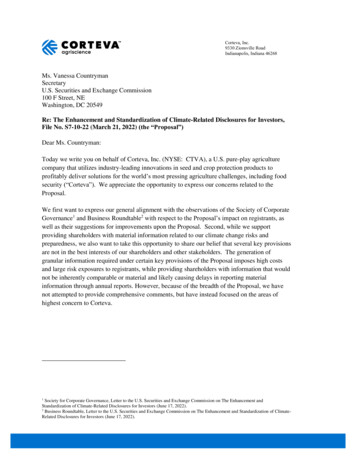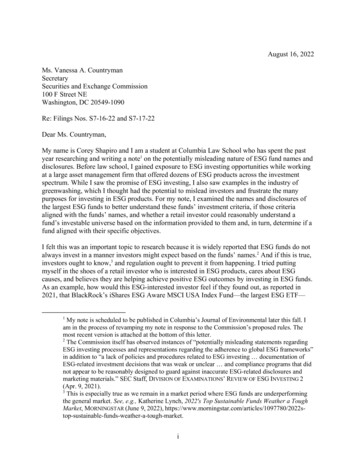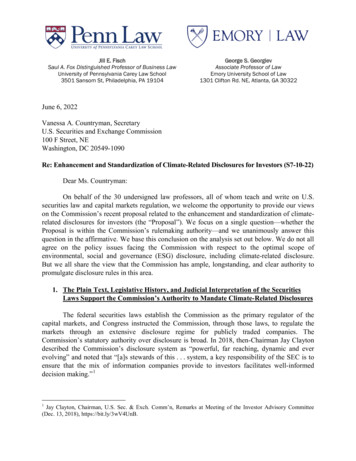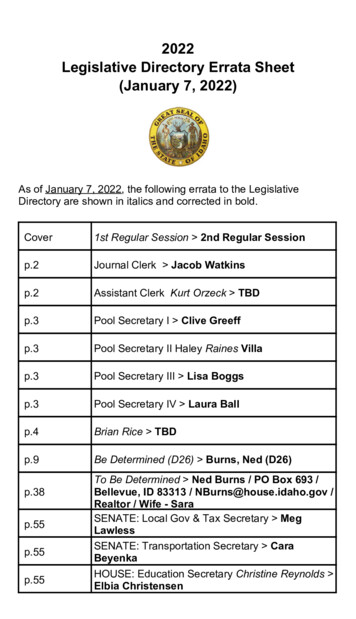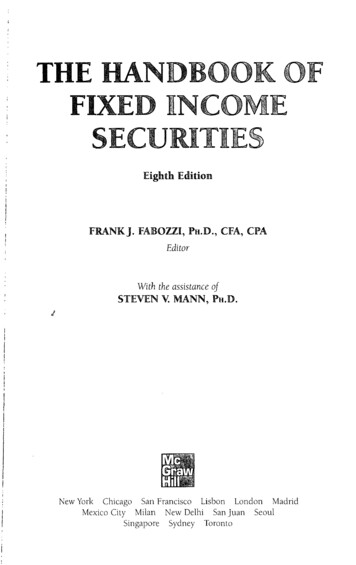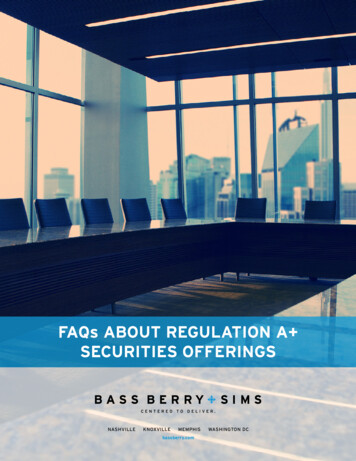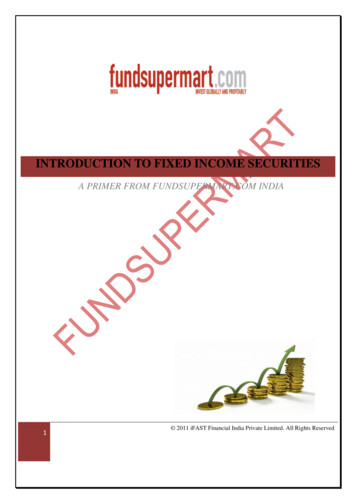
Transcription
June 16, 2022Vanessa A. CountrymanSecretarySecurities and Exchange Committee100 F. Street NEWashington, DC 20549-1090Via Email: rule-comments@sec.govRe:File No. S7-10-22 – The Enhancement andStandardization of Climate-RelatedDisclosures for InvestorsDear Ms. Countryman:We are a group of commentators with diverse experience in securities and corporationlaw, business management, accounting, and corporate governance generally. Combined, webring to bear well over a century’s work in areas bearing on these important issues, and althoughwe have diverse experiences and viewpoints on many issues, we have a shared interest in helpingthe Securities and Exchange Commission (the “Commission” or the “SEC”) grapple with, andpropose a cost-effective approach to, the urgent issue of providing American investors withimportant information on the effect climate change has on the companies in which they invest. 1It is in that spirit that we express our gratitude for the opportunity to comment on theCommission’s proposal to require public disclosure to investors of meaningful information aboutthe substantial risks that climate change poses for the issuers of publicly traded securities. Theseimportant disclosures will protect investors in those securities and help promote efficiency,competition, and capital formation.We speak solely in our individual capacities, but do set forth present and past affiliations so that our collectiveexperiences can be understood. Nothing we say should be interpreted as the position of any organization of anykind with which we have a present, past or future affiliation. We speak only for ourselves. We also wish toacknowledge the research and drafting assistance of Cody Westphal, Esquire and Nicole Hovatter, and the criticalsupport provided by Peggy Pfeiffer.1
To frame our comments, we wish to underscore our starting position. If the only choicewere to have the rule adopted as proposed, or to not have the rule, we would support adoption ofthe rule “as is.” Our reasoning is simple. The rule as proposed will help provide investors withuniform, more comprehensive disclosures and greatly enhance the availability of comparable,reliable data and information regarding climate change and its risks. A more than sufficientnumber of investors of all types have credibly claimed and demonstrated that these disclosureswill allow them to make more informed and better decisions regarding risks facing and valuationof the companies making these disclosures, and are therefore material to them and appropriatefor their protection.In our view, the proposed rule is a core exercise of the SEC’s well-established authorityto require disclosure necessary and appropriate to protect the integrity of our nation’s securitiesmarkets and the investors in those markets. Indeed, to conclude otherwise would upend settledunderstandings of securities law, and deny investors of all classes access to quality disclosures tomake prudent investing and voting decisions on issues that affect the future of Americancompanies and the American economy.It is in that supportive spirit that we advance the following comments, recognizing thatthe choice presented to us and the Commission is not between this rule and no rule, but alsoincludes what we believe is a better rule. We are therefore taking up the Commission’sinvitation to provide recommendations that will make the substantial benefits of the proposedrule even greater, while also reducing the implementation costs the proposed rule will impose onregistrants. Put simply, our view is that a rule of this kind will have substantial value forinvestors, and that if the suggestions we advance are adopted, the value of this rulemaking to-2-
investors will substantially increase, and be achieved at a much lower cost, and theCommission’s important investor-protection objectives will be better served.I.The SEC’s Statutory Authority to Require Climate Disclosure Important toInvestors Is Well-Established and Should Continue to Be Respected by theJudiciaryThe SEC’s statutory authority to require disclosure about the effect of climate change onissuers and the climate impact of issuers is firmly rooted in the statutory text. A fundamentalpower of the SEC since 1934 has been its authority to authorize the Commission to promulgaterules for registrant disclosure “as necessary or appropriate in the public interest or for theprotection of investors.” 2 That grant of authority was intentionally broad and designed to givethe SEC, which regulates dynamic aspects of a market economy, the power and “flexibility” toaddress “the complicated nature of the problems” that Congress aimed to resolve, includinginadequate disclosure. 3 For that reason, in keeping with Congressional intent, and withoutfurther explicit Congressional direction, the SEC has used its authority over the near-centurysince its creation to require disclosures on topics that have emerged as salient to the integrity ofmarkets and prudent investing, such as the: interests of affiliates in material transactionsinvolving an issuer; performance and background of management; management discussion andanalysis (“MD&A”); indemnification arrangements for officers and directors; executiveSee, e.g., 15 U.S.C. §§ 77g, 77j, 77s(a), 78c, 78i, 78j, 78l, 78m(a), 78n(a), 78o(d), and 78w(a); see also 15U.S.C. § 78n(a) (proxy solicitation), Sections 7, 10, 19(a) and 28 of the Securities Act of 1933, as amended (the“Securities Act”) and Sections 3(b), 12, 13, 15, 23(a) and 36 of the Securities Exchange Act of 1934, as amended(the “Exchange Act”). In 1996, Congress added Section 2(b) to the Securities Act and Section 23(a)(2) to theExchange Act, providing: “Whenever pursuant to this subchapter the Commission is engaged in rulemaking and isrequired to consider or determine whether an action is necessary or appropriate in the public interest, theCommission shall also consider, in addition to the protection of investors, whether the action will promoteefficiency, competition, and capital formation.” See 15 U.S.C. § 77(b).2See H.R. REP. NO. 73-1383, at 6-7 (1934); see also Nat. Res. Def. Council, Inc. v. SEC, 606 F.2d 1031, 1045(D.C. Cir. 1979) (concluding that Congress “opted to rely on the discretion and expertise of the SEC for adetermination of what types of additional disclosure would be desirable”).3-3-
compensation; mergers and acquisitions; disclosure controls and procedures; selective marketdisclosures; compensation discussion and analysis; board oversight of risk management; miningproperties; human capital management; and most recently, form and content of financialstatements. 4 As noted above, some of these topics and disclosures were or have become amongthe most salient to investors, and it has never been seriously suggested that the SEC’s otherwiseunquestioned broad disclosure authority should stop at the water’s edge of the most importantdisclosure subjects. That would be perverse and undermine the clear intent of the statutoryscheme.Consistently, and importantly, the Commission has for nearly a half century properlyused its authority to require disclosure regarding environmental and climate-related issues ofimportance to investors. 5 During the early 1970s, the Commission first required specificdisclosure by public companies of information about the environment. The Commission hasSee, e.g., Item 32 of Form S-1, Adopted in Miscellaneous Amendments, 14 Fed. Reg. 91, 92 (Dec. 31, 1948)(interests of affiliates in material transactions); Uniform and Integrated Reporting Requirements: Directors andExecutive Officers, Management Remuneration, Legal Proceedings, Principal Security Holders and SecurityHoldings of Management, 43 Fed. Reg. 34,402 (July 28, 1978) (performance and background of management);Amendments to Annual Report Form, Related Forms, Rules, Regulations, and Guides; Integration of Securities ActsDisclosure Systems, 45 Fed. Reg. 63-630 (Sept. 2, 1980) (to be codified at 17 C.F.R. pts. 229, 231, 239 et al.)(MD&A); Adoption of Integrated Disclosure System, 47 Fed. Reg. 11,380 (Mar. 3, 1982) (indemnificationarrangements for officers and directors); Executive Compensation Disclosure, 57 Fed. Reg. 29,582 (June 23, 1992)(to be codified at 17 C.F.R. pts. 229, 240); Mergers and Acquisitions, 34 Fed. Reg. 61,408, 61,443 (Oct. 22, 1999)(to be codified at 17 C.F.R. pts. 229.1000 through 229.1016); Disclosure Controls and Procedures, 68 Fed. Reg.36,636, 36,663 (June 5, 2003) (to be codified at C.F.R. pt. 229.307); Selective Disclosure and Insider Trading, 65Fed. Reg. 51,715 (Aug. 15, 2000) (to be codified at 17 C.F.R. pts. 240, 243, 249); Compensation and DiscussionAnalysis, 71 Fed. Reg. 53,158, 53,163 (Aug. 29, 2006) (to be codified at 17 C.F.R. pt. 229.402(b)(1)); ProxyDisclosure Enhancements, 74 Fed. Reg. 68,334 (Dec. 16, 2009) (to be codified at 17 C.F.R. pts. 229, 239, 240, 249,274) (board oversight of risk management); Modernization of Property Disclosures for Mining Registrants, 83 Fed.Reg. 66,344 (Oct. 31, 2018) (to be codified at 17 C.F.R. 229, pts. 230, 239, 249); Human Capital Disclosure, 85Fed. Reg. 63,726, 63,737 (Aug. 26, 2020) (to be codified at 17 C.F.R. pts. 229, 239, 240) (human capitalmanagement); Management’s Discussion and Analysis, Selected Financial Data, and Supplementary FinancialInformation, 86 Fed. Reg. 2,080 (Jan. 1, 2021) (to be codified at 17 C.F.R. pts. 210, 229 et al.) (modernizing,simplifying, and enhancing financial disclosure requirements).4See Disclosures Pertaining to Matters Involving the Environment and Civil Rights, Release Nos. 33-5170, 349252, 36 Fed. Reg. 13,989, 13,989 (July 19, 1971). The Commission has continued to require environmentaldisclosures and to refine those requirements over time. See Adoption of Integrated Disclosure System, Release No.33-6383 (47 Fed. Reg. 11,380) (Mar. 3, 1982) (codified at 17 C.F.R. pts. 200, 201, 229 et al.).5-4-
continued to require environmental disclosures and to further refine those requirements overtime. 6 More recently, in 2010 the Commission issued guidance that made clear that issuersshould consider more carefully whether matters relating to climate change fall within thecategories of information required to be disclosed in public filings under existing disclosurerequirements. 7In the mid-1970s, the Commission, after extensive consideration including publichearings, determined that investor protection interests would not at that time be further served byextensive additional disclosure requirements regarding environmental matters, and alsoconcluded that the National Environmental Protection Act did not require adoption of suchrules. 8 Relevant to the current rulemaking proposal, the Commission stated that its reasons notto engage in the requested extensive rulemaking included, first, the almost total lack of investorinterest in the requested extensive additional information, attributable in part to the absence atthat time of an appropriate uniform method for disclosure of environmental effects on issuers,and second, the excessive cost and administrative burdens. At the same time the Commissionmade clear that its broad discretion to require disclosure, including in the environmental area,would provide a statutory basis for expanding or contracting disclosure rules if warranted toSee Disclosure with Respect to Compliance with Environmental Requirements and Other Matters, Release Nos.33-5386, 34-10116, 38 Fed. Reg. 12,100 (Apr. 20, 1973) (citing NEPA, 42 U.S.C. §§ 4321 through 4333); see alsoAdoption of Integrated Disclosure System, Release No. 33-6383 (47 Fed. Reg. 11,380) (Mar. 3, 1982) (codified at17 C.F.R. pts. 200, 201, 229 et al.).6Commission Guidance Regarding Disclosure Related to Climate Change, Release Nos. 33-9106, 34-61469, 75Fed. Reg. 6,290 (Feb. 2, 2010).7Notice of Commission Conclusions and Rulemaking Proposals in the Public Proceeding Announced inSecurities Act Release No. 5569, Release No. 5627, (Oct. 14, 1975); Notice of Commission Conclusions and FinalAction on the Rulemaking Proposals Announced in Securities Act Release No. 5627 Related to EnvironmentalDisclosure, Release No. 5704 (May 6, 1976). The Commission’s decision was affirmed. Nat. Res. Def. Council,606 F.2d at 1051 (Congress has given the SEC “complete discretion” “to require in corporate reports” “suchinformation as it deems necessary” “to protect investors”).8-5-
address changes in the relevant business dynamic in which American public companies conducttheir business. 9Times change, especially so in the fast-moving arena of commerce. To that point, weunderscore that in making the current proposal, the Commission has concluded that there arecurrently the sorts of uniform methods that can frame disclosure mandates covering climaterelated matters and that there is current broad support for disclosure of climate-related mattersfrom investors of all types. Although some commentators have disparaged as irrelevant theviews of institutional investors, we do not, nor do the financial markets. In our experience,institutional investors are fierce competitors, unlikely to take a monolithic view, and, even moreimportant, investors like mutual funds and private equity funds are not known to, because inreality they do not, focus on issues unrelated to profit for themselves and their investors. 10 Whenleading investors have focused on climate recently, they have therefore done so within thecontext of focusing on sustainable returns for their investors, which they believe are threatenedby the adverse effects of climate change. 11Many institutional investors are also the managers of large pension funds and have multidecade investment mandates that require them to consider and mitigate risks that could impair9Id.See, e.g., John C. Coates IV & R. Glenn Hubbard, Competition in the Mutual Fund Industry: Evidence andImplications for Policy, 33 J. CORP. L. 151 (2007) (documenting fierce competition in the mutual fund industry);Justin Baer, Fidelity Eliminates Fees on Two New Index Funds, WALL ST. J. (Aug. 1, 2018, 5:20 nd-fees-tumble-to-zero-1533141096 (noting that the “race to zero”had “finally reached bottom” as Fidelity eliminated fees on certain of its index funds to put “pressure” on “rivals”such as Vanguard and Charles Schwab); Jeff Sommer, A Price War Has Driven Fund Fees to Zero. They May BeSet to Drop Further, N.Y. TIMES (Apr. 5, 2019), war-fundfees-zero-negative.html.10See, e.g., Larry Fink, CEO of BlackRock, 2020 Letter to CEOs: A Fundamental Reshaping of or-relations/2020-larry-fink-ceo-letter (stating that climate risk isinvestment risk, and that “[c]limate change has become a defining factor in companies’ long-term prospects”);Cyrus Taraporevala, CEO of State Street Global Advisors, CEO’s Letter on Our 2022 Proxy Voting insights/ceo-letter-2022-proxy-voting-agenda (“[C]limate change posessystemic risk to all investors.”).11-6-
their ability to deliver sustainable long-term returns necessary to ensure payment of theirbeneficiaries’ pensions. 12 To that point, climate change is also recognized by scientists,economists and actuaries as a systemic economic, not just social and human and environmental,problem. 13Every class of investor has expressed support for better climate disclosure, 14 and thegrowing interest of individual investors in funds that take climate change into account evidencesthat ordinary American investors understand the economic importance of this issue. 15 In ourSee, e.g., Statement of Investment Policy for the Teacher Retirement System of Texas Pension Fund (Sept.2021), nt policy statement.pdf (“In making investmentdecisions, the [pension] will consider ESG factors that are material to long-term returns and levels of risk.”);MARYLAND STATE RETIREMENT AND PENSION SYSTEM, MARYLAND PENSION RISK MITIGATION ACT ile-attachments/maryland pension risk mitigation act risk assessmentjanuary 2022 vf.pdf?1643730002 (the Board of Trustees of the Maryland State Retirement and Pension Systemestimates the impact of climate change on long-term risk and return forecasts across financial markets, consistentwith its long-term strategic asset allocation policy).12See INTERGOVERNMENTAL PANEL ON CLIMATE CHANGE, CLIMATE CHANGE 2022 REPORT: MITIGATION OFCLIMATE CHANGE (2022), https://report.ipcc.ch/ar6wg3/pdf/IPCC AR6 WGIII FinalDraft FullReport.pdf(assessing the “scientific, technological, environmental, economic, and social aspects” of climate change); see alsoNASA, Scientific Consensus: Earth’s Climate Is Warming, https://climate.nasa.gov/scientific-consensus/ (lastvisited May 25, 2022) (describing scientific consensus on climate change); Climate Change Working Party of theInstitute and Faculty of Actuaries, Climate Change for Actuaries: An Introduction, cument/Climate-change-report-29072020.pdf (revised July 2020) (“The reality of humaninduced climate change and the nature of the risks it poses is now accepted by almost all governments and policymakers worldwide.”); Governor Lael Brainard, Financial Stability Implications of Climate Change (Mar. 23, eech/brainard20210323a.htm.1314See U.S. Sec. & Exch. Comm’n, Recommendation from the Investor-as-Owner Subcommittee of the SECInvestor Advisory Committee Relating to ESG Disclosure (May 14, 2020), r-subcommittee-on-esg-disclosure.pdf; see alsoEmirhan Ilhan, Climate Risk Disclosure and Institutional Investors, Swiss Fin. Inst. Research Paper Series(Working Paper No. 661/2020, last revised Oct. 2021), https://ssrn.com/abstract 3437178 (noting that a survey of439 large institutional investors shows that seventy-nine percent of respondents believe that climate risk reporting isas important as traditional financial reporting, and almost one-third consider it to be more important); MACQUAIREASSET MANAGEMENT 2021 ESG SURVEY REPORT (2021), eport.pdf (noting that in a survey of 180 globalinstitutional real assets investors, including asset managers, banks, consultants and investment advisors, foundations,endowments, insurance companies, and pension funds, who combined represent more than 21 trillion of assetsunder management, more than half of responding investors selected climate change as their primary ESG concern).See MORGAN STANLEY INSTITUTE FOR SUSTAINABLE INVESTING, SUSTAINABLE SIGNALS: INDIVIDUALINVESTORS AND THE COVID-19 PANDEMIC (4th ed. 2021) (survey of 800 U.S. individual investors age eighteen orolder with minimum investable assets of 100,000 conducted on behalf of the Morgan Stanley Institute forSustainable Investing in which seventy-four percent of investors expressed interest in climate-themed investments);Ray Sin & Samantha Lamas, Are Your Clients ESG Investors?, MORNINGSTAR (Apr. 22, 2019), g-investors (Morningstar report showing seventy-two percent of the U.S.15-7-
collective view, when institutional investors of all diverse kinds—from public 16 and private 17pension funds, to charitable funds, 18 to private equity funds, 19 to actively traded mutual fundpopulation expressed at least a moderate interest in sustainable investing, defined as “balanced,” “sustainabilityminded,” or “sustainability-driven”); David Webber et al., Shareholder Value(s): Index Fund ESG Activism and theNew Millennial Corporate Governance, 93 S. CA. L. REV. 1250, 1302-04 (2020) (discussing the “importance” of theclimate change “phenomenon” in millennials’ investment decisions and stating that “investors [who] are committedto ESG investing” constitute nearly twenty-five percent of modern day investors).See, e.g., Gregory Zuckerman, Big Investors Reconsider Oil and Gas Upside as Supplies Remain Tight, WALLST. J. (May 12, 2022, 5:30 AM), 52330144?mod Searchresults pos1&page 1 (“For more than five years, endowments,pension funds, and other so-called institutional investors shunned the oil-and-gas industry because of . . . concernsabout climate change.”); Statement of Investment Policy for the Teacher Retirement System of Texas Pension Fund(Sept. 2021), nt policy statement.pdf (noting that thepension fund considers ESG factors such as climate change in making investment decisions); MARYLAND STATERETIREMENT AND PENSION SYS., MARYLAND PENSION RISK MITIGATION ACT (2022), achments/maryland pension risk mitigation act risk assessment january 2022 vf.pdf?1643730002 (describing the Maryland state pension funds’ adoption of Task Force on Climate-Related Disclosure(TCFD) standards).16See, e.g., Statement of Investment Principles for the General Motors (VML) Pension Plan (Sept. tors/fileviewer.aspx?FileID 12879&FileName vml sip.pdf (“TheTrustee expects [General Motors Investment Management Corporation] and its investment managers to take accountof financially material considerations including climate change and other ESG considerations.”); Statement ofInvestment Principles for the Coca-Cola Enterprises Pension Scheme (Feb. 2022), ewer.aspx?FileID 12916&FileName feb 2022 sip update.pdf (listing as a key investmentbelief “climate change is a financially material systemic issue that presents risks and opportunities for the Schemeover the short, medium and long term,” and stating expectations that investment managers take into account climatechange as a financially material factor); Statement of Investment Principles for the Caterpillar DC Pension Plan(Sept. 2021), 0/00/01/07/DocumentDocument FILE/Caterpiller-DC-Plan-SIP-September-2021.pdf (stating that the pension trustee has selected climate change andcarbon emissions as among its key areas for voting focus); Statement of Funding and Investment Principles for theExxonMobil Pension Plan (Dec. 2020), grijke-documenten/beleid/beleggingsbeginselen-sip/ (stating that the pension plan considered environmental, social, and governanceconsiderations, including but not limited to climate change); Annual Statements for the IBM Pension Plan (Dec.2020), lan-2020.pdf (“The Trustee believes that ESGfactors, including climate change, can impact the performance of the Plan’s investments . . . over the medium tolong-term.”); Statement of Investment Principles for the Raytheon Systems Limited Pension Scheme (Aug. tment%20Principles%20002.pdf (“The Trustees also recognise that long-term sustainability issues, particularlyclimate change, present risks and opportunities that increasingly require explicit consideration.”).17See, e.g., WALTON FAMILY FOUNDATION, WATER & CLIMATE: THE OPPORTUNITY BEFORE US ning/water-climate-the-opportunity-before-us (“The material impactsof climate change on critical industries is clear in a wide variety of ways.”); Duke University Board of Trustees,Statement on Climate Change and Investment (May 8, 2020) (acknowledging the “grave challenges posed byclimate change” and directing management of Duke’s endowment to take climate change into account).18See, e.g., CLIMATE-RELATED CORPORATE STRATEGY, NEUBERGER BERMAN 6 (2022) (“We . . . urge[]governments to step up their ambition to achieve the goals of the Paris Agreement, support investment in the lowcarbon transition and improve climate-related financial disclosures.”); Dawn Lim, Carlyle Sets Its PortfolioCompanies a 2050 Net Zero Target, BLOOMBERG (Feb. 1, 2022, 1:50 PM), ero-target (“Carlyle . . . is taking severalactions to bring the businesses it owns more in line with the Paris Climate Agreement.”); SILVER LAKE,19-8-
complexes, 20 to index funds 21—consider consistent, comparable, and reliable information aboutclimate-related risks important, that buttresses the SEC’s determination that climate-relateddisclosures are appropriate to protect investors and thus within its core statutory authority tomandate.The SEC is authorized to be responsive when there is broad demand in the investorcommunity for information on an important topic relevant to the viability and prospects of publichttps://www.silverlake.com/purpose/ (last visited May 21, 2022) (“We aim to . . . evaluate material ESGconsiderations across our portfolio—we believe sustainable, inclusive growth generates stronger stakeholderreturns.”); BLACKSTONE, AN INTEGRATED APPROACH TO ESG 11, 20 (Nov. 2021) (stating that Blackstone haspartnered with the TCFD to help build a “more resilient” financial system, as quality disclosure affects the “longterm resilience and growth” of companies and assets); Institutional Ltd. Partners Ass’n, ESG Data ConvergenceProject, https://ilpa.org/ilpa esg roadmap/esg data convergence project/ (last visited May 23, 2022) (describing aproject to streamline the private investment industry’s historically fragmented approach to collecting and reportingESG data to create a critical mass of meaningful, performance-based, comparable ESG data from private companies,with a global group of over 100 general partners and limited partners representing 8.7 trillion in assets undermanagement and 1,400 portfolio companies).See, e.g., FIDELITY ASSET MANAGEMENT ESG INVESTING TEAM, REPORT ON INVESTMENT SUSTAINABILITY ANDIMPACT (2021), https://www.fidelity.com/bin-public/060 www fidelity com/documents/mutual-funds/Stewardshipreport.pdf (“Our expectations for the companies we invest in are evolving as we encourage a greater focus on, anddisclosure of, issues related to ESG risks and opportunities.”); News Release, T. Rowe Price, T. Rowe PriceReleases 2020 Sustainability Report (July 8, 2021), bility-report (“Utilizing both the SASB and TCFD frameworks providesour clients and stakeholders . . . and, as an asset manager, is consistent with the recommendation we make to ourinvestee companies for how they can enhance their own ESG disclosures.”); Anne Simpson, Why the SEC is Rightto Make Climate Risk Disclosure Mandatory, FIN. TIMES (Mar. 30, 2022), 1e7c1e9e946a (presenting argument from the Global Head of Sustainability at Franklin TempletonInvestments as to the necessity for consistent climate disclosure requirements); FRANKLIN TEMPLETON MARTINCURRIE FUND, STEWARDSHIP ANNUAL REPORT 2022 at 7, 15 (2022) (stating that “as investors,” the fund uses“activity and dialogue with investee companies” to broaden “engagement activity at [the] portfolio level” and“encourage greater detail around climate transition risk”).20See, e.g., 2020 Letter to Clients: Sustainability as BlackRock’s New Standard for Investing, stor-relations/2020-blackrock-client-letter (last visited May 19, 2022)(discussing BlackRock’s desire for clear, consistent ESG disclosure standards, and founding involvement in theTCFD); STATE STREET GLOBAL ADVISORS, GUIDANCE ON CLIMATE-RELATED DISCLOSURES (Jan. sures.pdf(encouraging all public companies in State Street portfolios to offer public disclosures in accordance with the fourpillars of the TCFD and advocating for increased transparency in key areas of climate transition disclosure); CyrusTaraporevala, The Other Climate Risk Investors Need to Talk About, FIN. TIMES (May 14, 3-8b43-3839e668fe3a (urging the SEC to consider the need foruniform requirements for both public companies and private companies); VANGUARD, VANGUARD INVESTMENTSTEWARDSHIP INSIGHTS: CLIMATE RISK GOVERNANCE 3-4 (2020), -commentary/ISCLRG 062020.pdf (arguing thateffective and quality climate disclosure is essential to investors and supporting a consistent and universal disclosureframework).21-9-
companies. 22 Although it is of course the right of anyone to oppose the merits of an SECproposed rule, it would, in our view, be inconsistent with settled law, and an exercise inunprincipled judicial adventurism, to conclude that the SEC’s broad authority to requiredisclosures “necessary or appropriate in the public interest or for the protection of investors” 23does not include the power to require disclosures on a topic universally considered important byinvestors themselves.II.Universal Disclosure by All Public Companies of Scope 1 and 2 Emissions IsTransformational and the Proposal Underestimates Its Benefits— EspeciallyIf the Commission Addresses Outsourcing of Core Economic Functions andRequires Apples-to-Apples Reporting on Scope 1 and 2The SEC’s requirement that all public companies disclose Scope 1 and 2 greenhouse gas(“GHG”) emissions in substantial alignment with the well-recognized GHG Protocolpromulgated by the World Resources Institute and the World Business Counc
Executive Officers, Management Remuneration, Legal Proceedings, Principal Security Holders and Security Holdings of Management, 43 Fed. Reg. 34,402 (July 28, 1978) (performance and background of management); Amendments to Annual Report Form, Related Forms, Rules, Regulations, and Guides; Integration of Securities Acts


